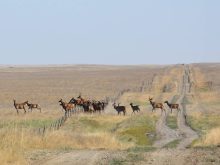NEEPAWA, Man. – Bill Fraser went through almost two months this summer without any rain worth mentioning at his farm west of Neepawa.
Despite the prolonged dry spell, Fraser was expecting good yields and quality as he began harvesting his wheat last week. He credits rain earlier in the year for cushioning his crops against the withering heat and dry weather that descended on much of the Prairies this summer.
“We had good rainfalls in June. I think that’s what saved us.”
When interviewed Aug. 22, Fraser said his farm had received almost no rain since June 26. It was only on Aug. 20 that he finally got another 10 millimetres.
Read Also

Crop quality looks good this year across Prairies
Crop quality looks real good this year, with the exception of durum.
Fraser’s situation was shared by many Manitoba farmers this year, especially those on the west side of the province and in the northern Interlake region. However, the meagre moisture and scorching summer heat did not deliver the devastating blow to cereal crops that might have been expected under those conditions, at least not to the earlier-seeded wheat and barley crops.
“The reports we are getting is that yields are not as bad as initially feared in some areas,” said Bruce Burnett, the Canadian Wheat Board’s director of weather and crop surveillance.
The cereal crop harvest in Manitoba advanced quickly this year because of favourable harvesting weather.
With at least 80 percent of those crops already in the bin, Burnett said it looks as though Manitoba’s overall wheat and barley harvest will be at least average this year and possibly above average because of bumper yields in the central and eastern regions of the province.
Moisture-loving diseases were less of a menace this year, which improved the odds of reaping better quality crops. The dry weather caused some concern about the plumpness and protein levels of barley grown for malting, especially in southwestern Manitoba, Burnett said.
In Saskatchewan, where the cereal crop harvest is about half completed, overall yields of wheat and barley are expected to be below average, but in step with producers’ expectations, Burnett said.
Insects and dry weather kept a lid on yield. Some of the most stressed crops were in the southeast, south-central and west-central parts of the province.
“We are seeing some surprises in Saskatchewan,” said Burnett. “Some guys are finding a little bit higher yields than they expected.”
Saskatchewan’s 10-year average for spring wheat yields is 31 bushels per acre. The 10-year average for barley is 51 bu. per acre.
Saskatchewan Agriculture last gave its estimate of expected yields in early August. Even then, the department was expecting overall crop yields to be only 84 percent of the provincial 10-year average. The next yield estimate will not be released until September.
The quality of spring wheat harvested in Saskatchewan has been good so far, with most grading No. 1 or No. 2. As in Manitoba, barley quality benefited from less disease pressure, but suffered somewhat due to lack of moisture in the drier areas of the province.
“I think from a quality perspective, there’s not necessarily as much good news as there is with wheat, but it’s certainly not terrible either,” Burnett said.
In Alberta, the harvest is not as far advanced as it is in Saskatchewan and Manitoba. When interviewed Aug. 25, Burnett estimated Alberta’s harvest was only 20 percent complete, with the south accounting for the bulk of the progress made so far.
In its July 31 estimate of production, Statistics Canada calculated that spring wheat yields in Alberta would come in at about 35 bu. acre, while barley would be just over 54 bu. per acre.
Although it appears those estimates could be in the ball park, Burnett emphasized that things could change once the harvest becomes more general throughout Alberta.














